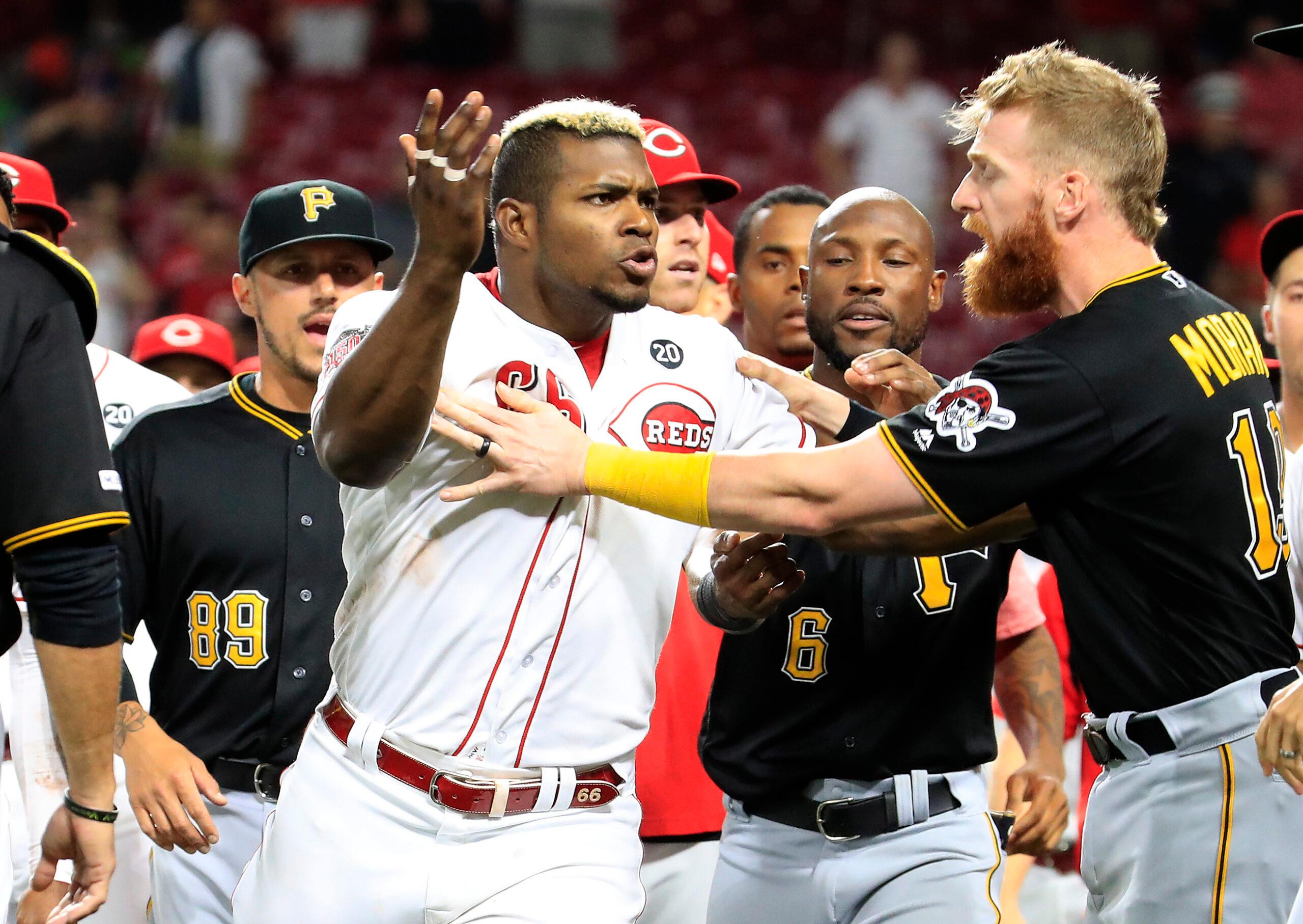
Trevor Bauer’s last throw with Cleveland, it turns out, wasn’t a pitch to the plate, but rather a 400-foot launch of a ball in frustration, from the pitcher’s mound over the center-field fence. Yasiel Puig’s last act with Cincinnati, meanwhile, was full-fledged involvement in a benches-clearing brawl.
But that’s not all that was revealed in a Tuesday night blockbuster, as a quiet, slumbering trade market woke with a shout: In a three-team deal, Cincinnati traded for Bauer, last year’s no. 6 Cy Young finisher; Cleveland acquired Puig, outfielder Franmil Reyes, pitching prospect Logan Allen, and lesser minor-leaguers Scott Moss and Victor Nova; and San Diego added outfield prospect Taylor Trammell to its collection of young talent.
The trade represents a fascinating exchange that eschews the standard “present All-Star for prospects” format that typically occurs in late July: The team in a playoff position traded a top starter, the team seven games under .500 added him, and the team with maybe the best farm system in baseball shuffled out some young players for another. Let’s go team by team to examine the outcome for each—starting with Cleveland, whose involvement in a deal of this kind is, in some manner, the culmination of nine months of flirting.
Cleveland
Since last offseason, Cleveland has considered trading Bauer—a strange convention for a player who made the All-Star team in 2018 and might have won the Cy Young if he hadn’t suffered a broken leg in August. His 2.21 ERA ranked second in the AL, his 2.44 FIP first, and he appeared to make significant developmental strides with his pitch mix and effectiveness.
Bauer’s trade still seems strange in some respects; Cleveland entered Tuesday with a lead in the AL wild-card race, just two games back of Minnesota in the AL Central, with a chance at winning its fourth division title in a row. For an ownership group that has displayed notorious frugality, a trade of Bauer, who is set to make in the neighborhood of $20 million in arbitration next season and will be a free agent thereafter, fits first as a way to tighten the purse strings of player payroll.
Yet in dealing Bauer for players who can help the team now, the Cleveland front office took advantage of an area of strength to shore up an area of weakness. Even without Bauer, Cleveland has the upside for the best rotation in the American League. Shane Bieber (3.40 ERA, 31.1 percent strikeout rate after Tuesday’s start) and Mike Clevinger (3.28 ERA, 37.5 percent K rate) are just as good as Bauer, if not better, and if Corey Kluber (broken arm) and Carlos Carrasco (treatment for leukemia) can return before October, the rotation would be as dominant as ever in a playoff series.
The latter part of that formula is no guarantee, of course, and Cleveland assumes a fair amount of risk by trading Bauer, who at the worst profiles as an above-average innings-eater. Yet it seems a fair assumption of risk because of the reward on the position-player side. Cleveland’s outfield looked abysmal in the winter and has mostly played to form, with a combined 91 wRC+ (24th in the majors) and 2.5 WAR (23rd) this season. While a hefty portion of that underperformance came from players no longer on the roster, Puig and Reyes still represent considerable offensive upgrades over the team’s extant options.
Puig struggled to adjust in his first few months away from Dodger Stadium, but the riotously entertaining outfielder has perked up of late. His season line still looks lackluster compared to his Dodger days given the slow start, but since June 14, he’s hitting .324/.383/.640. He is a free agent after this season, but he should help Cleveland immensely in the key period before he reaches the open market.
Joining him in Cleveland is the ex-Padre Reyes, who isn’t as well known as the famous former Dodger but might be an even better hitter. With a career 122 wRC+ and 43 home runs in a full season’s worth of plate appearances, as well as a 6-foot-5, 275-pound frame that makes him the closest thing to Aaron Judge outside New York, Reyes is a masher of a man, and he should power a Cleveland lineup that ranks just 19th in the majors in home runs. Reyes might not be able to play in the field long term, but now that he moves to an American League park, that’s not a problem: Cleveland doesn’t have a true DH in its lineup and can easily slot Reyes’s bat into the cleanup spot.
Of Cleveland’s prospect additions, Nova is 19 years old and playing in rookie ball; FanGraphs doesn’t even consider him worthy of a prospect grade, so he’s unlikely to shift the balance of the deal much. Ditto with Moss, a Double-A pitcher. Allen, meanwhile, places 111th in FanGraphs’ prospect rankings, with the site describing the 22-year-old lefty as “a near-ready no. 4 starter.” He hasn’t shown much in Triple-A this season, or in eight games at the MLB level (four starts), in which he’s posted a 6.75 ERA, but he throws three average-or-better pitches and could help Cleveland down the stretch this season, to say nothing of the future.
Ultimately, Cleveland’s rationale for this deal is more sensible than other iterations of a Bauer trade. The move might backfire—as is true of all transactions in baseball, particularly high-stakes deadline deals involving established players—but it could also round out a more holistic roster and bolster Cleveland in its march up the American League standings. Nothing ventured, nothing gained.
Cincinnati
The same philosophy, and concomitant embrace of risk, has flowed through Cincinnati’s front office since last winter, when the Reds made a series of win-now moves despite four consecutive last-place finishes. One of those trades brought in Puig, another Sonny Gray—who has essentially reverted to his Oakland A’s performance now that he’s left New York and made this year’s All-Star squad—but the individual successes haven’t helped Cincinnati into contention. The Reds’ underlying numbers are still strong (e.g., a plus-26 run differential), but they entered play Tuesday 6.5 games out of a playoff spot in the crowded NL middle.
But that setback apparently didn’t lessen Cincinnati’s aggressiveness; like the Mets, who are also on the fringes of the 2019 playoff picture but still traded for Marcus Stroman, the Reds swooped in ahead of more concrete contenders to add a top pitcher with 1.5 years of team control. Bauer might not be able to help the Reds reach October this year, but he positions them well for next year, when Luis Castillo, Gray, and Bauer might form one of the majors’ best three-man rotation units.
That’s a mighty large might, though, because it’s unclear how close 2019 Bauer actually is to maximizing his potential. Bauer turned in a tremendous 2018 season, but that is also his only standout season to date. His ERA was 50 percent better than the league average last year and his FIP 42 percent better, but his best-ever season other than 2018 retreats much closer to the middle: 21 percent better than average by ERA or 12 percent better by FIP. By DRA—Baseball Prospectus’s flagship ERA estimator, which uses a variety of adjustments to estimate a pitcher’s context-neutral performance—Bauer has been almost exactly league average this season.
Bauer’s 2019 season has been defined by inconsistency, with 11 games allowing two or fewer runs but seven games allowing five or more. Compared to last year, Bauer has amassed fewer strikeouts, more walks, fewer ground balls, more hard contact, and many more home runs—this after a ludicrously lucky, league-leading homer-per-fly ball rate in 2018 that juiced his numbers beyond his pure talent level. If Bauer regains all those underlying strengths going forward, he will regain his acehood—but that’s a lot of indicators headed in the wrong direction, pointing more toward frustratingly occasional excellence rather than guaranteed top-of-the-rotation starter.
And that statistical analysis doesn’t even dip into the multitudinous potential issues a Bauer addition to a clubhouse might wreak. This weekend’s on-mound implosion, when he responded to a poor start by firing the game ball over the outfield wall, was just the latest, and most on-field, manifestation of his difficulty.
Given the team’s current position, it is effectively making another one-year-only move, like it did with Puig. Perhaps, if next season doesn’t work out either, the Reds can trade Bauer again at the 2020 deadline, like they did with Puig on Tuesday. But there’s a narrow margin for success here—particularly when considering the final part of Cincinnati’s side, as the Reds shipped out Trammell, their top-rated prospect, as well.
San Diego
The Padres had too many players for too few corner positions, needing to fit Reyes, Manny Machado, Eric Hosmer, Wil Myers, Hunter Renfroe, Josh Naylor, and other youngsters into the same slots, with no DH to assist. As Michael Baumann outlined last month, the Padres “have nine players for four spots in the lineup.”
Exit Franmil, to loosen that positional constriction, and enter Trammell, who offers San Diego the young center fielder it wanted. The speedy 21-year-old, picked 35th in the sandwich round of the 2016 draft, ranks 32nd on FanGraphs’ list, with future 70 grades on the 20-80 scouting scale for his running and fielding. But like many up-the-middle players with that athletic profile, Trammell carries questions about his ability to hit at a commensurate level, and he’s had trouble translating his tools into success in Double-A this season (.236/.350/.338, just six home runs).
Some prospect evaluators have dinged Trammell for that performance and the underlying holes in his game it exposes, and San Diego is no stranger to touted center fielders who can’t hit enough to stick as an MLB starter. Their very experience with Manny Margot, who came to the Padres in the Craig Kimbrel trade with Boston, explains why they need a new center fielder now. But San Diego also had so many outfielders and so many pitching prospects that it evidently felt like it could sacrifice one member from each pool to try to fix Trammell’s swing, and thus, like Cleveland, use a position of strength to address a position of weakness. The only difference is that Cleveland made the trade for the next three months; San Diego, with Trammell still in Double-A, made the trade with the next three years and more in mind as it builds its next contending roster.
Here, too, the trade is fraught with risk if particular player trajectories veer off track. Just last year, the Padres sent Cleveland two sought-after relievers, including All-Star Brad Hand, for a prospect with especially wide error bars, and catcher Francisco Mejía has hit .212/.268/.370 in San Diego. When the Padres are next ready to push for the playoffs, Reyes could bash 40 homers for Cleveland while Trammell struggles to make contact in the minor leagues.
Yet like with Cleveland and Cincinnati, on some level, San Diego clearly believes in its ability to optimize its newest player’s performance. The front office thinks the upside is worth the risk. That bit of common sense is inherently true of every transaction, but especially for one of this nature; with no clear buyer vs. seller delineations, it’s all the more enticing for the added dynamic. The trade deadline is still an afternoon away, but it already may have delivered its most thought-provoking deal.

